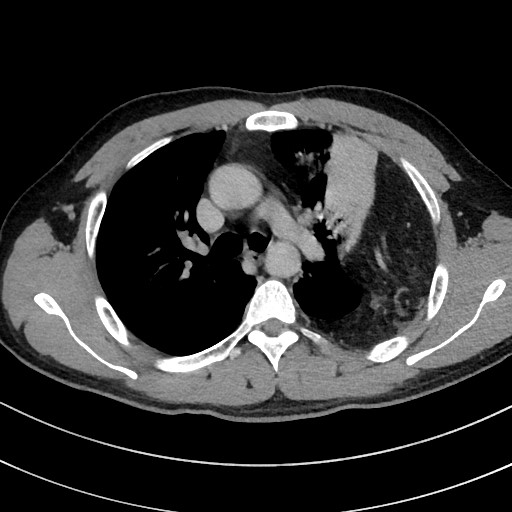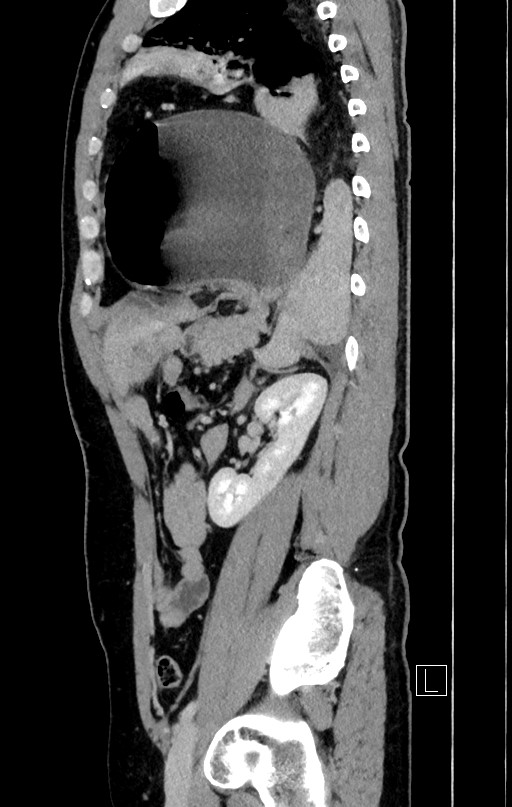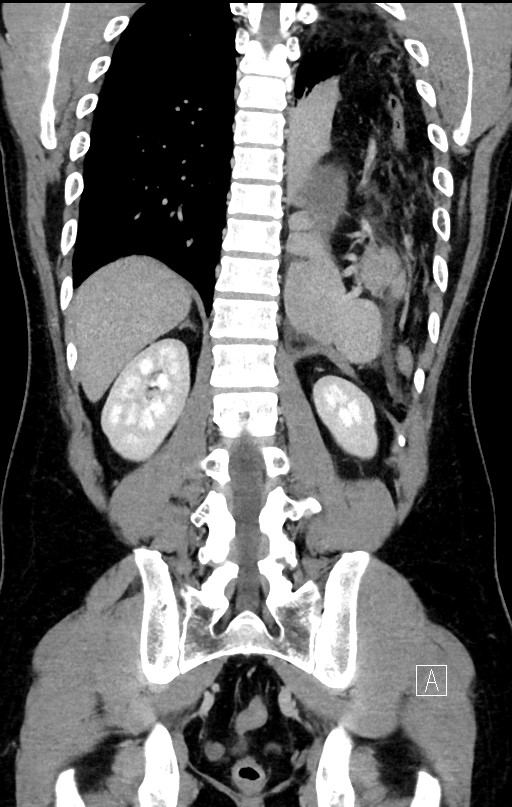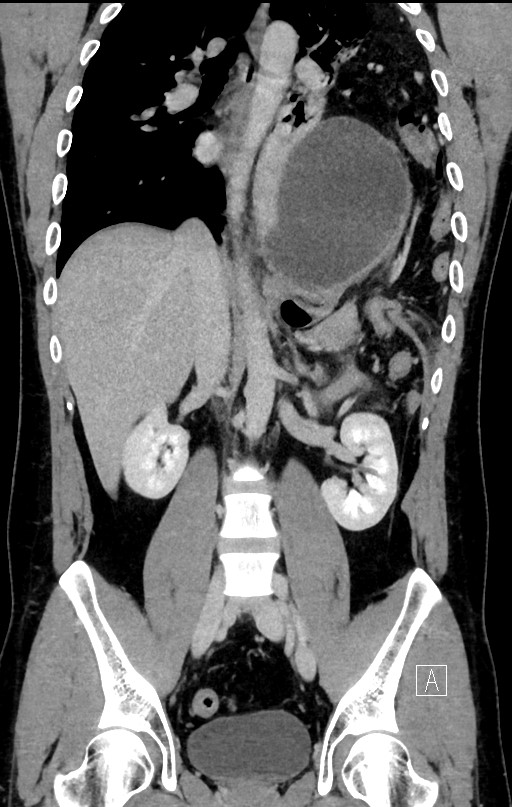Answer of October 2021
For completion of the online quiz, please visit the HKAM iCMECPD website: http://www.icmecpd.hk/
Clinical History:
A 40-year-old gentleman presented with sudden onset of severe epigastric pain and intractable retching. There was no preceding history of trauma.
Chest radiograph:
Contrast CT thorax, abdomen and pelvis:
IMAGING FINDINGS
Chest radiograph: There was loss of normal left diaphragmatic contour with large gas fluid level density at the left upper quadrant extending to left lower zone. Normal gastric bubble is not identified. No evidence of pneumoperitoneum or gastric pneumatosis.
CT thorax, abdomen and pelvis: There was a large left posterolateral diaphragmatic hernia with herniation of intrabdominal contents into the left hemithorax, including most of the stomach, spleen, pancreatic tail, and large bowels. The stomach was markedly distended and rotated along its long axis with greater curvature displaced superiorly. There was presence of antropyloric transition point without associated mass within. The stomach showed preserved mural enhancement without any intramural or portovenous gas. No pneumoperitoneum was present to suggest gastric perforation. Prominent mesenteric vasculature and mesenteric fat stranding within the hernia sac was indicative of incarcerated diaphragmatic hernia. There was significant mass effect to left hemithorax with contralateral mediastinal midline shift with complete compressive atelectasis of left lingula segment and left lower lobe.
DIAGNOSIS:
Organoaxial gastric volvulus with incarcerated diaphragmatic hernia.
DISCUSSION:
Gastric volvulus is a life-threatening surgical emergency due to its risk of gastric ischemia, necrosis, and perforation. Early recognition and appropriate treatment are crucial to avoid potential complications. Gastric volvulus is defined as abnormal rotation of stomach and categorized according to their axes of rotation. There are three types of gastric volvulus, including organo-axial volvulus, mesenteroaxial volvulus and mixed type from the above two. Borchardt triad is a triad for clinical presentations of gastric volvulus, including sudden severe epigastric pain, intractable retching without vomiting and inability to pass a nasogastric tube into the stomach.
Organoaxial volvulus occurs when the stomach rotates along its longitudinal axis, which is a line jointing the esophagogastric junction and pylorus. It is the most common type of the gastric volvulus, which accounts for approximately two-thirds of the cases. In organoaxial volvulus, the greater curvature is displaced superiorly, and the lesser curvature is displaced inferiorly. The antrum rotates anterosuperiorly while the fundus rotates posteroinferiorly. A large Bochalek hernia is a predisposing factor for organoaxial gastric volvulus which is more commonly present in childhood. If it is presented in adulthood, it is more often to be associated with paraesophageal hernia or post-traumatic diaphragmatic rupture.
Mesenteroaxial volvulus occurs when the stomach rotates along the short axis and perpendicular to the cardiopyloric line (a line drawn from gastric cardia and pylorus). There is a reversal of relationship of gastroesophageal junction and pylorus with antrum displaced above the gastroesophageal junction. The greater and lesser curvatures are in normal in position relative to each other, in contrast with organoaxial volvulus. Partial rotation is more often (less than 180 degree) and can present in chronic setting. It is less often to be associated with diaphragmatic defect. The mixed type is the rarest form of gastric volvulus occurs when the stomach rotates in both organoaxial and mesenteroaxial axes.
Upper gastrointestinal barium is highly sensitive for gastric volvulus as it can show the relationship between different stomach segments clearly. However, it is contraindicated when gastric perforation is suspected. Peritoneal spillage of barium could occur and result in potential life-threatening barium peritonitis. Computed tomography is highly sensitive and specific for diagnosing gastric volvulus. The sensitive direct sign includes antropyloric transition point without any mass at transition. It is useful to determine the axis of rotation of stomach, associated complications, and predisposing factors such as diaphragmatic defects. It is also useful to identify factors associated with gastric volvulus such as wandering spleen, malrotation with asplenia and agenesis of left liver. Non-surgical treatment includes decompression by nasogastric tube. Surgical treatments include detorsion of the volvulus, reductions of herniated contents, closure of diaphragmatic defect and fixation of the stomach to anterior abdominal wall.







